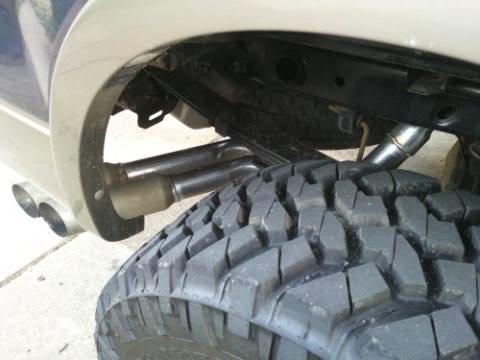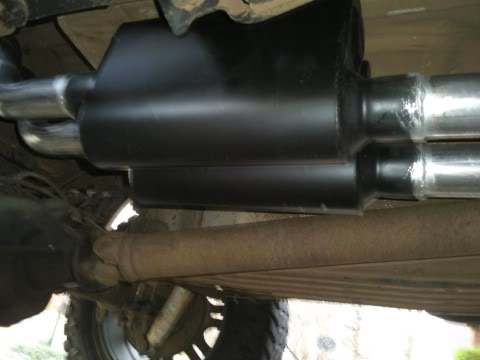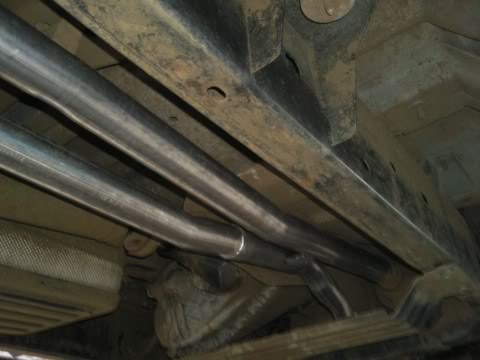True dual exhaust question
#1
Junior Member
Thread Starter
Join Date: Apr 2012
Location: Little rock AFB,AR
Posts: 13
Likes: 0
Received 0 Likes
on
0 Posts
Those of you that have true dual exhaust how much did it cost to get it done? And what kind of mufflers are you guys running and what size piping?
#5
Cost will vary with what materials you bring, what material, and bending is used. If you bring the X/H pipe and mufflers it should be much less. Piping and muffler recommendations are in the exhaust sticky in my sig.
#7
Mine cost me about $500 total. I took it to a guy that makes any exhaust you are looking for (custom  ). Anyways, true duals, flowmaster mufflers (who cares what series, their FLOWMASTER's!), and Ford Raptor tips.
). Anyways, true duals, flowmaster mufflers (who cares what series, their FLOWMASTER's!), and Ford Raptor tips.



 ). Anyways, true duals, flowmaster mufflers (who cares what series, their FLOWMASTER's!), and Ford Raptor tips.
). Anyways, true duals, flowmaster mufflers (who cares what series, their FLOWMASTER's!), and Ford Raptor tips.


Last edited by Nice Sweater; 04-26-2012 at 07:14 PM.
Trending Topics
#9
Just so everyone knows an X or H pipe has a specific purpose and a person just can't add one wherever they pls and expect to work as intended. For a crossover to function properly and scavenge the exhaust the way they are designed they need to be installed in a specific spot. An old school method of determining the correct spot to install the crossover is to spray paint the exhaust system or paint a line down the pipes and wherever the paint stops burning Is close to the correct placement and will achieve the best scavenging effect.
#10
Here is a great write up that was posted years ago by a very knowledgable member
Cross Over Exhaust Pipe Explained...
With all this discussion about changing Mufflers and Exhausts I thought I would take a moment to explain why you have a cross over pipe (what we call an H or X pipe!), and the difference in concept between the two popular designs. This might help you decide if you which you want to go with!
The firing order of all production V8s, regardless of make, has one cylinder in each bank that will fire within 90 degrees of crankshaft rotation of another cylinder in the same bank. This occurs twice during completion of the entire firing order. These two cylinders will be exhausting almost simultaneously into the same exhaust manifold system.
Full-length four-tube headers help separate these pulses until the collector is reached. If this is a full race car running "open exhaust", you will notice the collector dumps into a short open pipe at least 2.5 times the size of the header pipes, or the header pipes dump direct without a collector. This is done to avoid the conflict of pressure caused by the timing of the 2 counter firing cylinders, which will create back pressure and degrade torque, horsepower and general performance, especially at higher RPM.
On a full exhaust system, after the header tubes dump into the collectors, the two close firing cylinders are fighting each other for space in the collector and exhaust pipe. The result is reflected pressure waves traveling back up the exhaust system, backpressure, lost power and poor economy.
At the same time two cylinders exhaust in one bank, there is no activity in the opposite bank. The traditional H-pipe equalizer allows some of the excess pressure to bleed over to the 'quiet side' of the exhaust system, resulting in some low and mid-range torque improvements. At high RPMs, however, in traditional exhaust systems, the gases cannot bleed across the H-pipe fast enough to help power significantly. Performance systems with the H pipe design, attempt to over come this by using a shorter cross over pipe which is also slightly larger in diameter as the main exhaust, then would be used in a standard exhaust.
To overcome the power loss of "over loading" the H pipe design, Exhaust manufacturers came up with the X pipe design, which features a tangentially Siamese crossover junction to synchronize exhaust pulses. The X-pipe concept is to split the flow in the crossover junction, so the pressures on both banks will be equal and pulse-free after the crossover, regardless of the rpm. Volumetric efficiency and power are therefore improved at all engine speeds. The negative aspect to the X pipe design is, because of the crisscrossing of the flow stream, harmonic pulsations will develop on some systems at certain RPMs, which will be perceived as a buzzing or humming sound.
A newer concept is a "Channel Pipe", where as two pipes are welded together in parallel with a baffle in between them which allows for mismatched pressures and pulses to cross to the idle side while allowing full, uninterrupted or redirected flow of the exhaust stream through the system.
Also... There is yet another option.... The MAC Prochamber.
It looks like a box, or a muffler where the 2 header leads enter one end and then exit the other in the location of the H or X pipe.
It is essentially a combination of all three basic designs I discussed, incorporating the crossover flow of an X pipe āEUR" the open buffer of an H pipe and the passive pulse control of a ported baffle channel pipe. MAC is the ONLY maker to have this design.
Basically it combines the exhaust into a single box, where the 2 inlets extend into the box a few inches to prevent reversion and open dumping exhaust into the box. The outlets are flush with the back of the box and there is a baffle between the sides with ported slots directing the flow of the inlets to cross to the other side. The Box holds backpressure at a steady rate, which eliminates scavenging.
There are many who believe the Prochamber will give increased performance values. Everyone using them will tell you they make a deeper yet quieter tone to the exhaust note.
Tuned systems are nearly always with a crossover pipe because the length and diameter of the exhaust is specifically designed to work with your engine at a specified RPM Range to avoid reversion and scavenging.
It has been proven that in some instances, a crossover pipe will decrease backpressure and allow for a higher flow. If the crossover pipe is too close to the engine, it allows the pulse timing of the opposing cylinders to crash into each other, the pressure from a right cylinder will still be present in the left pipe when the left cylinder opens to vent. Too far a placement can create a unequal vacuum¯, causing diminished pressure on the venting opposing cylinder, causing decrease in torque (Called Scavenging). .
Proper design and placement of the cross over will allow a balance of pressures across the system and therein increase torque, especially at lower RPM
After a cylindar fires and the piston cycles ¯ - exhausts gas vents through the Exhaust valves, along with the remainder of the pulses¯, exiting the cylinder into the exhaust system.
This explosion creates 2 pulse causes a Sonic Pulse - and a Thermal Pulse.
When the faster Sonic Pulse leaves the exhaust it has created a vacuum in the pipe behind it, which air pressure will enter the pipe to fill the vacuum. This air will collide with the Thermal Pulse and cause it to reverse. The timing of this event causes exhausted gases to be returned to the cylinder while the exhaust valve is still open therein not allowing all the spent gas to escape and also polluting the environment for your next stroke cycle with fresh air/fuel mix.
So you ask - "Which is the BEST one to have?"
I am sorry to say - the answer to that question is purly subjective.
Cross Over Exhaust Pipe Explained...
With all this discussion about changing Mufflers and Exhausts I thought I would take a moment to explain why you have a cross over pipe (what we call an H or X pipe!), and the difference in concept between the two popular designs. This might help you decide if you which you want to go with!
The firing order of all production V8s, regardless of make, has one cylinder in each bank that will fire within 90 degrees of crankshaft rotation of another cylinder in the same bank. This occurs twice during completion of the entire firing order. These two cylinders will be exhausting almost simultaneously into the same exhaust manifold system.
Full-length four-tube headers help separate these pulses until the collector is reached. If this is a full race car running "open exhaust", you will notice the collector dumps into a short open pipe at least 2.5 times the size of the header pipes, or the header pipes dump direct without a collector. This is done to avoid the conflict of pressure caused by the timing of the 2 counter firing cylinders, which will create back pressure and degrade torque, horsepower and general performance, especially at higher RPM.
On a full exhaust system, after the header tubes dump into the collectors, the two close firing cylinders are fighting each other for space in the collector and exhaust pipe. The result is reflected pressure waves traveling back up the exhaust system, backpressure, lost power and poor economy.
At the same time two cylinders exhaust in one bank, there is no activity in the opposite bank. The traditional H-pipe equalizer allows some of the excess pressure to bleed over to the 'quiet side' of the exhaust system, resulting in some low and mid-range torque improvements. At high RPMs, however, in traditional exhaust systems, the gases cannot bleed across the H-pipe fast enough to help power significantly. Performance systems with the H pipe design, attempt to over come this by using a shorter cross over pipe which is also slightly larger in diameter as the main exhaust, then would be used in a standard exhaust.
To overcome the power loss of "over loading" the H pipe design, Exhaust manufacturers came up with the X pipe design, which features a tangentially Siamese crossover junction to synchronize exhaust pulses. The X-pipe concept is to split the flow in the crossover junction, so the pressures on both banks will be equal and pulse-free after the crossover, regardless of the rpm. Volumetric efficiency and power are therefore improved at all engine speeds. The negative aspect to the X pipe design is, because of the crisscrossing of the flow stream, harmonic pulsations will develop on some systems at certain RPMs, which will be perceived as a buzzing or humming sound.
A newer concept is a "Channel Pipe", where as two pipes are welded together in parallel with a baffle in between them which allows for mismatched pressures and pulses to cross to the idle side while allowing full, uninterrupted or redirected flow of the exhaust stream through the system.
Also... There is yet another option.... The MAC Prochamber.
It looks like a box, or a muffler where the 2 header leads enter one end and then exit the other in the location of the H or X pipe.
It is essentially a combination of all three basic designs I discussed, incorporating the crossover flow of an X pipe āEUR" the open buffer of an H pipe and the passive pulse control of a ported baffle channel pipe. MAC is the ONLY maker to have this design.
Basically it combines the exhaust into a single box, where the 2 inlets extend into the box a few inches to prevent reversion and open dumping exhaust into the box. The outlets are flush with the back of the box and there is a baffle between the sides with ported slots directing the flow of the inlets to cross to the other side. The Box holds backpressure at a steady rate, which eliminates scavenging.
There are many who believe the Prochamber will give increased performance values. Everyone using them will tell you they make a deeper yet quieter tone to the exhaust note.
Tuned systems are nearly always with a crossover pipe because the length and diameter of the exhaust is specifically designed to work with your engine at a specified RPM Range to avoid reversion and scavenging.
It has been proven that in some instances, a crossover pipe will decrease backpressure and allow for a higher flow. If the crossover pipe is too close to the engine, it allows the pulse timing of the opposing cylinders to crash into each other, the pressure from a right cylinder will still be present in the left pipe when the left cylinder opens to vent. Too far a placement can create a unequal vacuum¯, causing diminished pressure on the venting opposing cylinder, causing decrease in torque (Called Scavenging). .
Proper design and placement of the cross over will allow a balance of pressures across the system and therein increase torque, especially at lower RPM
After a cylindar fires and the piston cycles ¯ - exhausts gas vents through the Exhaust valves, along with the remainder of the pulses¯, exiting the cylinder into the exhaust system.
This explosion creates 2 pulse causes a Sonic Pulse - and a Thermal Pulse.
When the faster Sonic Pulse leaves the exhaust it has created a vacuum in the pipe behind it, which air pressure will enter the pipe to fill the vacuum. This air will collide with the Thermal Pulse and cause it to reverse. The timing of this event causes exhausted gases to be returned to the cylinder while the exhaust valve is still open therein not allowing all the spent gas to escape and also polluting the environment for your next stroke cycle with fresh air/fuel mix.
So you ask - "Which is the BEST one to have?"
I am sorry to say - the answer to that question is purly subjective.
Last edited by cyberdude47; 04-27-2012 at 12:10 AM.



